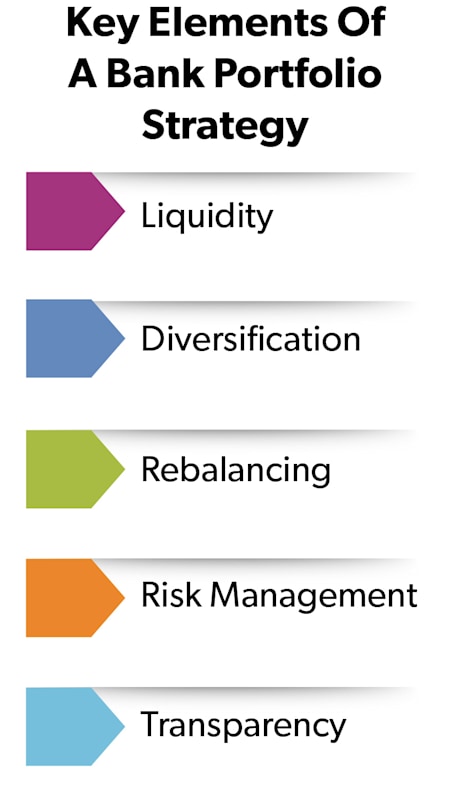As our financial landscape continues to evolve, prudent bank portfolio investment remains crucial to banking industry resilience and sustainability. Navigating these dynamic environments requires a solid grasp of fundamental principles and strategic approaches.
A well-managed investment portfolio can help bank executives meet financial goals and objectives, while also providing liquidity and diversification.
However, managing a bank's investment portfolio is not simple. As we saw earlier in 2023, when banks invest too heavily in securities that involve interest rate risk, their capital shrinks. Aside from interest rate risk, banks are subject to a variety of risks, including credit risk, basis risk, market risk, and liquidity risk. A sound investment portfolio strategy addresses these risks and tries to mitigate them.
This article will discuss the key pillars of sound bank portfolio investment, including diversification, risk management, asset allocation, and more. Our aim is to provide insights that can improve your institution's investment strategy, drive growth, and increase stability even amidst economic fluctuations.
Bank Investment Portfolio Strategy Basics
A sound investment portfolio strategy for banks features several basic elements. These can include:
 Liquidity: Banks need to have access to enough liquidity to meet their obligations. We advise executives to concentrate on building a solid ladder of cash flows to provide liquidity as rates rise or fall.
Liquidity: Banks need to have access to enough liquidity to meet their obligations. We advise executives to concentrate on building a solid ladder of cash flows to provide liquidity as rates rise or fall.
Diversification: Banks need to diversify their investment portfolio to reduce their overall risk. For instance, Silicon Valley Bank held securities classified as “held to maturity” (HTM) that lost value as interest rates rose. With its large influx of deposits, the investment portfolio grew to more than half its assets. By contrast, many other banks invested only about 25% of their assets allocated in a variety of different investment types to mitigate interest rate risk.
Rebalancing: Rebalancing involves periodically adjusting the asset allocation and potentially executing an exit strategy of securities in a portfolio to ensure that it remains consistent with the bank's risk tolerance and investment objectives.
Risk management: Banks need to have a sound risk management framework to identify and mitigate the risks associated with their investment portfolio. This includes having a clear understanding of the risks they face, developing policies and procedures to mitigate those risks, and monitoring their portfolio on an ongoing basis.
Transparency: Banks need to be transparent about their investment activities. This means providing clear and accurate information about the composition of their investment portfolios, the risks they face, and the performance of their investments.
Best Practices For Managing A Bank Investment Portfolio
After the 2023 bank failures, bank executives are scrutinizing their investment portfolio strategy and process — and so are bank regulators. As experts in bank financials, we’ve always recommended a comprehensive approach since this important function is much more than a single person can handle. Best practices involve setting up an investment committee, defining investment strategies, implementing strategies to manage liquidity, working with brokers, and conducting thorough documentation and analyses.
The Importance Of A Bank Investment Portfolio Committee
The Bank Consulting experts at First Business Bank always recommend forming an investment committee within banks, as it brings transparency, mitigates key person risk, and expands the decision-making process. The investment committee facilitates open discussions, ensures alignment with the balance sheet strategy, and enhances the overall investment process.
Your bank’s investment portfolio committee should include key stakeholders, such as the CEO, President, CFO, and representatives from your asset-liability committee (ALCO) and lending departments.
What Should Bank Investment Portfolio Committee Meetings Address?
Regular bank investment portfolio committee meetings are typically conducted quarterly. They provide a platform to review investment trades, board and broker execution, balance sheet positioning, liquidity and economic forecasts, and the existing investment portfolio.
One critical outcome of these meetings is the development of a written investment strategy that outlines the bank's approach, guiding principles, and risk tolerance. This strategy ensures consistency, guards against deviating from the plan, and provides a framework for decision-making.
How Should Banks Decide on Investments For Their Portfolios?
When evaluating investment opportunities, we can’t emphasize enough the importance of balancing yield and total return. Total return encompasses both income earned from a security and its market value adjustment over time. While market value fluctuations are important to monitor, the focus ultimately should be on income generation and its impact on the balance sheet margin.
Drawing on past experiences, our team cautions against overemphasizing market value while neglecting income. We have witnessed instances where investments with high total return did not yield sufficient bottom-line income.
Taking Interest Rate Risk Into Consideration
Given the current environment as we anticipate future rate hikes, bank executives might consider a barbell approach focusing on intermediate-duration securities. Concentrating on well-structured, sequential collateralized mortgage obligations (CMOs) and mortgage-backed securities (MBS) with favorable prepayment can help manage risk and position the portfolio for potential rate increases.
Additionally, we recommend exercising caution with tight-spread products and when considering Treasury securities. It’s vitally important to align your investment decisions with the previously defined investment portfolio strategy.
The Role of Brokers in Investment Management
Brokers play a pivotal role in investment management, providing insights, economic information, analytics support, and access to various investment opportunities. Bank executives are well-served by maintaining strong relationships with brokers and ensuring they understand and align with the bank's investment strategy.
Trust, knowledge, and compatibility are essential qualities in a broker, as they should act as partners with you, offering suitable investment options within the bank's guidelines and not pushing unsolicited offers.
Trade Documentation and Post-Purchase Analysis
Transparency and accountability demand thorough documentation of trades, including trade tickets with complete details, notes on the rationale behind the investment, and confirmation from brokers.
We recommend maintaining transaction logs, preparing trade summaries, and conducting post-purchase analysis to monitor credit changes, market value fluctuations, yield, and prepayment risks. Regular portfolio reviews allow for necessary adjustments and restructuring as market conditions and bank strategies evolve.
Benefits Of Hiring An Experienced Investment Portfolio Consultant
There are many benefits when you work with a consultant to develop and execute your bank’s investment portfolio strategy. A consultant can leverage their relationships with brokers, provide pricing expertise, and ensure the bank receives the best possible deals. By treating the consultant as an extension of the bank's team, the bank can access comprehensive market insights, optimize investment decision-making, and enhance its investment portfolios.




